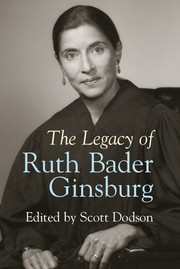Book contents
- Frontmatter
- Contents
- Contributors
- Preface
- Acknowledgments
- Part I Shaping a Legacy
- 1 Notes on a Life
- 2 Ruth Bader Ginsburg
- 3 Before Frontiero There Was Reed
- 4 Struck by Stereotype
- A Postscript to Struck by Stereotype
- 5 Beyond the Tough Guise
- Part II Rights and Remedies
- Part III Structuralism
- Part IV The Jurist
- Notes
- Index
2 - Ruth Bader Ginsburg
Law Professor Extraordinaire
Published online by Cambridge University Press: 05 February 2015
- Frontmatter
- Contents
- Contributors
- Preface
- Acknowledgments
- Part I Shaping a Legacy
- 1 Notes on a Life
- 2 Ruth Bader Ginsburg
- 3 Before Frontiero There Was Reed
- 4 Struck by Stereotype
- A Postscript to Struck by Stereotype
- 5 Beyond the Tough Guise
- Part II Rights and Remedies
- Part III Structuralism
- Part IV The Jurist
- Notes
- Index
Summary
On August 10, 1993, for the first time in U.S. history, a female attorney general (Janet Reno) presented the commission of a president (William Clinton) to seat a female justice (Ruth Bader Ginsburg) on the United States Supreme Court. Ginsburg, a tireless advocate for equality between men and women, joined Sandra Day O’Connor as the second woman and the 107th justice on the high court. Ginsburg’s professional life before becoming a justice was unusual because she did not come from the public or private practice of law. Rather, she had spent the first seventeen years of her career as a law professor before accepting President Carter’s appointment to the United States Court of Appeals for the District of Columbia Circuit in 1980. With her elevation to the Supreme Court, she became only the sixth justice and the first female to have held a tenured appointment on a law school faculty. This chapter presents an overview of her academic background as a prelude to examining how that experience might have influenced her work on the Court.
Background and Legal Training
Born in Brooklyn on March 15, 1933, to Jewish-American parents of Central European and Russian ancestry, Ginsburg credits her mother, Celia Bader, for encouraging her intellectual development. She amply repaid that investment by graduating first among the women in her class and being elected to Phi Beta Kappa at Cornell University in 1954. At Cornell, she met and married an upperclassman, Martin D. Ginsburg; both decided to study law. She later recalled that she had been inspired to become a lawyer “because of my horror at what Joe McCarthy, who saw a communist in every corner, was doing to the country.” She saw the “brave lawyers, standing up for the people who were called before the Senate Internal Security Committee, the House Un-American Activities Committee” and wanted to prepare herself to fill a similar role.
Information
- Type
- Chapter
- Information
- The Legacy of Ruth Bader Ginsburg , pp. 12 - 30Publisher: Cambridge University PressPrint publication year: 2015
Accessibility standard: Unknown
Why this information is here
This section outlines the accessibility features of this content - including support for screen readers, full keyboard navigation and high-contrast display options. This may not be relevant for you.Accessibility Information
- 3
- Cited by
